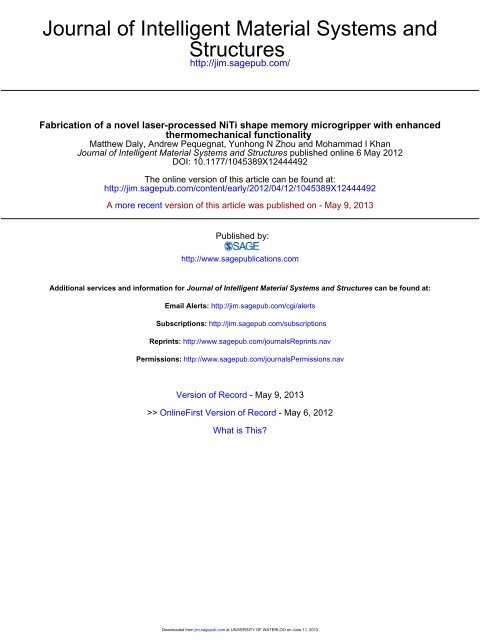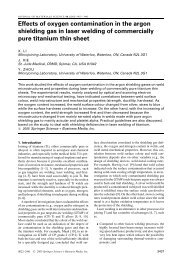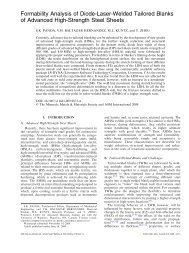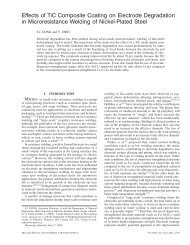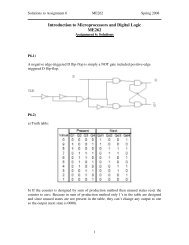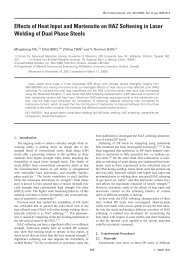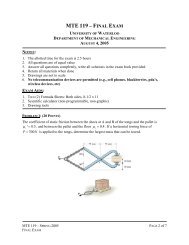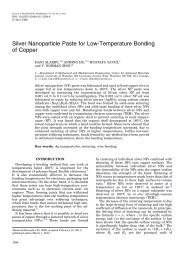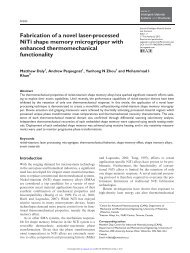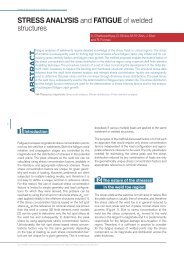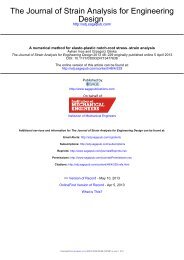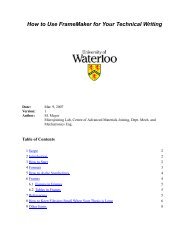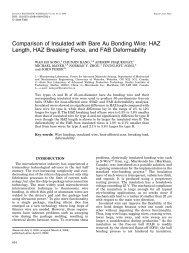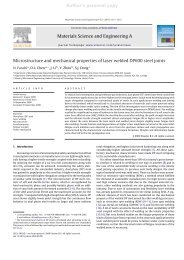Fabrication of a Novel Laser Processed NiTi Shape Memory ...
Fabrication of a Novel Laser Processed NiTi Shape Memory ...
Fabrication of a Novel Laser Processed NiTi Shape Memory ...
You also want an ePaper? Increase the reach of your titles
YUMPU automatically turns print PDFs into web optimized ePapers that Google loves.
Journal <strong>of</strong> Intelligent Material Systems and<br />
Structures<br />
http://jim.sagepub.com/<br />
<strong>Fabrication</strong> <strong>of</strong> a novel laser-processed <strong>NiTi</strong> shape memory microgripper with enhanced<br />
thermomechanical functionality<br />
Matthew Daly, Andrew Pequegnat, Yunhong N Zhou and Mohammad I Khan<br />
Journal <strong>of</strong> Intelligent Material Systems and Structures published online 6 May 2012<br />
DOI: 10.1177/1045389X12444492<br />
The online version <strong>of</strong> this article can be found at:<br />
http://jim.sagepub.com/content/early/2012/04/12/1045389X12444492<br />
A more recent version <strong>of</strong> this article was published on - May 9, 2013<br />
Published by:<br />
http://www.sagepublications.com<br />
Additional services and information for Journal <strong>of</strong> Intelligent Material Systems and Structures can be found at:<br />
Email Alerts: http://jim.sagepub.com/cgi/alerts<br />
Subscriptions: http://jim.sagepub.com/subscriptions<br />
Reprints: http://www.sagepub.com/journalsReprints.nav<br />
Permissions: http://www.sagepub.com/journalsPermissions.nav<br />
Version <strong>of</strong> Record - May 9, 2013<br />
>> OnlineFirst Version <strong>of</strong> Record - May 6, 2012<br />
What is This?<br />
Downloaded from jim.sagepub.com at UNIVERSITY OF WATERLOO on June 11, 2013
Article<br />
<strong>Fabrication</strong> <strong>of</strong> a novel laser-processed<br />
<strong>NiTi</strong> shape memory microgripper with<br />
enhanced thermomechanical<br />
functionality<br />
Journal <strong>of</strong> Intelligent Material Systems<br />
and Structures<br />
0(0) 1–7<br />
Ó The Author(s) 2012<br />
Reprints and permissions:<br />
sagepub.co.uk/journalsPermissions.nav<br />
DOI: 10.1177/1045389X12444492<br />
jim.sagepub.com<br />
Matthew Daly 1 , Andrew Pequegnat 1 , Yunhong N Zhou 1 and Mohammad I<br />
Khan 2<br />
Abstract<br />
The thermomechanical properties <strong>of</strong> nickel-titanium shape memory alloys have sparked significant research efforts seeking<br />
to exploit their exotic capabilities. Until recently, the performance capabilities <strong>of</strong> nickel-titanium devices have been<br />
inhibited by the retention <strong>of</strong> only one thermomechanical response. In this article, the application <strong>of</strong> a novel laserprocessing<br />
technique is demonstrated to create a monolithic self-positioning nickel-titanium shape memory microgripper.<br />
Device actuation and gripping maneuvers were achieved by thermally activating processed material regions which<br />
possessed unique phase transformation onset temperatures and thermomechanical recovery characteristics. The existence<br />
<strong>of</strong> each thermomechanical material domain was confirmed through differential scanning calorimetry analysis.<br />
Independent thermomechanical recoveries <strong>of</strong> each embedded shape memory were captured using tensile testing methods.<br />
Deployment <strong>of</strong> each embedded shape memory was achieved using resistive heating, and in situ resistivity measurements<br />
were used to monitor progressive phase transformations.<br />
Keywords<br />
nickel-titanium, laser processing, microgripper, thermomechanical behavior, shape memory effect, shape memory alloys,<br />
smart materials<br />
Introduction<br />
With the surging demand for microsystems technology<br />
in the aerospace and biomedical industries, a significant<br />
need has developed for elegant smart material mechanisms<br />
to replace conventional electromechanical systems.<br />
Nickel-titanium (<strong>NiTi</strong>) shape memory alloys (SMAs)<br />
are considered a top candidate for a variety <strong>of</strong> nextgeneration<br />
smart material applications because <strong>of</strong> their<br />
excellent combination <strong>of</strong> mechanical properties and<br />
biocompatibility (Duerig et al., 1999; Fu et al., 2001;<br />
Hartl and Lagoudas, 2007). While <strong>NiTi</strong> has enjoyed<br />
relative success in many microsystems devices, future<br />
technologies demand more precise control over its functional<br />
thermomechanical properties, namely the shape<br />
memory effect.<br />
As in other SMA systems, the mechanism responsible<br />
for shape memory behavior in the <strong>NiTi</strong> system is a<br />
reversible thermoelastic austenite–martensite phase<br />
transformation. Given that the phase transformation<br />
onset temperatures in <strong>NiTi</strong> alloys are extremely sensitive<br />
to alloy composition and processing history (Miller<br />
and Lagoudas, 2001; Tang, 1997), efforts to create<br />
application-specific <strong>NiTi</strong> alloys have proven to be problematic.<br />
Furthermore, the functionality <strong>of</strong> conventional<br />
<strong>NiTi</strong> alloys is limited by the retention <strong>of</strong> only<br />
one shape memory response. A novel material processing<br />
protocol is therefore required to overcome the performance<br />
limitations <strong>of</strong> traditional <strong>NiTi</strong> fabrication<br />
technologies.<br />
Recent investigations have shown that exposure to<br />
high-density laser energy can alter thermomechanical<br />
1 Centre for Advanced Materials Joining (CAMJ), Department <strong>of</strong><br />
Mechanical and Mechatronics Engineering, University <strong>of</strong> Waterloo,<br />
Waterloo, Canada<br />
2 Smarter Alloys Inc., MaRS Centre, Toronto, Canada<br />
Corresponding author:<br />
Matthew Daly, Centre for Advanced Materials Joining (CAMJ),<br />
Department <strong>of</strong> Mechanical and Mechatronics Engineering, University <strong>of</strong><br />
Waterloo, 200 University Avenue West, Waterloo, ON, N2L 3G1,<br />
Canada.<br />
Email: m3daly@uwaterloo.ca<br />
Downloaded from jim.sagepub.com at UNIVERSITY OF WATERLOO on June 11, 2013
2 Journal <strong>of</strong> Intelligent Material Systems and Structures 0(0)<br />
behavior in <strong>NiTi</strong> by shifting phase transformation<br />
onset temperatures within the processing region (Daly<br />
et al., 2011, 2012; Khan and Zhou, 2010a; Pequegnat<br />
et al., 2011). This technique, referred to as multiple<br />
memory material (MMM) technology, can be used to<br />
locally tune the thermomechanical response <strong>of</strong> conventional<br />
<strong>NiTi</strong> SMAs (Khan and Zhou, 2010b, 2011).<br />
<strong>Laser</strong> processing with MMM technology therefore permits<br />
the localized embedment <strong>of</strong> unique shape memory<br />
responses within a monolithic <strong>NiTi</strong> structure; thus,<br />
enhancing the functionality <strong>of</strong> <strong>NiTi</strong> by augmenting its<br />
thermomechanical characteristics. The purpose <strong>of</strong> this<br />
study is to implement laser processing to fabricate a<br />
novel <strong>NiTi</strong>-based microsystems device with enhanced<br />
thermomechanical functionality.<br />
Given the complicated path trajectories demanded<br />
from smart material microsystems technologies, monolithic<br />
fabrication <strong>of</strong> <strong>NiTi</strong> devices is usually not practical<br />
and SMA components are <strong>of</strong>ten integrated into hybrid<br />
packages (Kohl, 2004). For example, several hybrid<br />
designs exist for <strong>NiTi</strong> microgripper heads. Lee et al.<br />
(1996) have developed a passively biased SMA microgripper<br />
by sputtering a <strong>NiTi</strong> film onto a silicon substrate<br />
and Kohl et al. (2000) created an integrated<br />
antagonistic SMA microgripper through laser micromachining<br />
<strong>of</strong> a <strong>NiTi</strong> thin sheet. Although each <strong>of</strong> these<br />
designs achieves gripper actuation through exploitation<br />
<strong>of</strong> the shape memory effect, device performance is<br />
inherently limited by their reliance on external systems<br />
to position the microgripper head during gripping<br />
operations. In order to eliminate the need for external<br />
positioning systems, presented in this study is a monolithic<br />
laser-processed <strong>NiTi</strong> microgripper capable <strong>of</strong> selfpositioning.<br />
Actuation <strong>of</strong> positioning segments and the<br />
device gripper head is achieved through the sequential<br />
activation <strong>of</strong> unique thermomechanical regimes. The<br />
added thermomechanical functionality <strong>of</strong> the laserprocessed<br />
<strong>NiTi</strong> eliminates the need for external positioning<br />
systems and greatly reduces the complexity <strong>of</strong><br />
the <strong>NiTi</strong> microsystems device. To the author’s knowledge,<br />
this study represents the first example <strong>of</strong> a monolithic<br />
<strong>NiTi</strong> microgripper that possesses multiple<br />
recoverable thermomechanical characteristics.<br />
nominal postoptic spot size <strong>of</strong> 600 mm. In order to process<br />
larger lengths <strong>of</strong> <strong>NiTi</strong> wire, a custom fixture was<br />
designed to advance the wire between laser pulses.<br />
Processing parameters were selected to locally embed<br />
three unique thermomechanical responses within the<br />
as-received <strong>NiTi</strong> alloy, as per the previous study (Khan,<br />
2010). In each laser-processing schedule, full melting <strong>of</strong><br />
the base metal was achieved. The two lower temperature<br />
thermomechanical material domains were designed<br />
to actuate the positioning segments <strong>of</strong> the microgripper<br />
and the higher temperature shape memory was used to<br />
close the microgripper head. In order to avoid contamination<br />
during laser-processing operations, argon shielding<br />
was provided to the processing region at a flow rate<br />
<strong>of</strong> 0.42 m 3 /h (15 ft 3 /h). After laser-processing operations,<br />
the wire was resistively shape trained using a<br />
Sorensen XG series 33-25 programmable direct current<br />
(DC) power supply. Figure 1 illustrates the processing<br />
dimensions <strong>of</strong> the <strong>NiTi</strong> wire and microgripper shape set<br />
geometry.<br />
In order to confirm the embedment <strong>of</strong> independent<br />
thermomechanical material domains within the laserprocessed<br />
<strong>NiTi</strong> microgripper, differential scanning<br />
calorimetry (DSC) analysis was used to capture changes<br />
in phase transformation onset temperatures in the <strong>NiTi</strong><br />
samples. DSC scans were performed using a Thermal<br />
Analysis Q2000 system equipped with a refrigerated<br />
cooling system. As-received and laser-processed samples<br />
were prepared for comparison. Given the high<br />
power densities associated with laser processing, a heattreated<br />
wire specimen was also analyzed to ensure that<br />
changes in phase transformation onsets were not the<br />
result <strong>of</strong> localized annealing <strong>of</strong> the as-received material.<br />
Sample data was collected using a modified ASTM<br />
µ<br />
Experimental<br />
Commercially available 410 mm diameter <strong>NiTi</strong> wire<br />
with a nominal composition <strong>of</strong> 50.8 at.% Ni and 49.2<br />
at.% Ti was used for microgripper construction. Prior<br />
to laser processing, the surface oxides were removed<br />
using a hydr<strong>of</strong>luoric–nitric acid etching agent; uniformly<br />
reducing the diameter <strong>of</strong> the wire to 380 mm.<br />
<strong>Laser</strong> processing was achieved using a Miyachi<br />
Unitek pulsed neodymium-doped yttrium aluminum<br />
garnet (Nd:YAG) laser system (Model LW50 A) which<br />
produced a 1.06 mm wavelength beam and possessed a<br />
Figure 1. Processing dimensions <strong>of</strong> the <strong>NiTi</strong> microgripper (not<br />
to scale): (a) dimensions <strong>of</strong> the laser-processed <strong>NiTi</strong> wire and<br />
(b) configuration <strong>of</strong> the laser-processed regions after resistive<br />
shape setting.<br />
Downloaded from jim.sagepub.com at UNIVERSITY OF WATERLOO on June 11, 2013
Daly et al. 3<br />
F2004-05 testing protocol. Heat flow was measured at a<br />
controlled heating and cooling rate <strong>of</strong> 5°C/min, and<br />
austenite and martensite start and finish temperatures<br />
(A s , A f , M s , and M f , respectively) were defined following<br />
the ASTM standard.<br />
Thermomechanical recovery <strong>of</strong> the laser-processed<br />
<strong>NiTi</strong> samples was assessed using an Instron model 5548<br />
microtensile machine with a 60.5 mm measurement<br />
accuracy. Tensile samples were loaded at room temperature<br />
(20°C) under an ASTM F2516-07 testing protocol<br />
at a rate <strong>of</strong> 1.0 mm/min to 6% strain and then<br />
subsequently relaxed. Upon complete unloading, laserprocessed<br />
samples were heated in situ to above A f in an<br />
environmental chamber in order to activate each<br />
embedded thermomechanical response. A zero load<br />
condition was maintained at the crossheads and displacement<br />
feedback was continuously recorded in order to<br />
assess material recovery. The measured displacement<br />
was then normalized against the final length <strong>of</strong> the<br />
<strong>NiTi</strong> wire and then correlated with collected temperature<br />
data to track shape memory recovery.<br />
Temperature measurements were recorded using a thin<br />
film resistance temperature detector (RTD) with an<br />
uncertainty <strong>of</strong> 61.3°C<br />
Actuation <strong>of</strong> the laser-processed <strong>NiTi</strong> microgripper<br />
was achieved by resistive heating methods that were<br />
controlled using a National Instruments PXI-1031 data<br />
acquisition module equipped with a RTD. In order to<br />
assess phase transformations in situ, online resistivity<br />
measurements were captured by monitoring applied<br />
voltage and current loads during microgripper actuation.<br />
In order to eliminate high-frequency signal noise<br />
from alternating current (AC) line voltages, the collected<br />
thermomechanical and resistivity data were filtered<br />
using a low-pass Butterworth algorithm (Bianchi<br />
and Sorrentino, 2007).<br />
Results and discussion<br />
Detection <strong>of</strong> embedded thermomechanical behavior<br />
The collected DSC scans and corresponding phase<br />
transformation onset temperatures are shown in<br />
Figure 2 and Table 1, respectively. Examination <strong>of</strong> the<br />
as-received sample showed a single diffuse subambient<br />
phase transformation. The broad transformation range<br />
and low hysteresis were typical <strong>of</strong> trained <strong>NiTi</strong> and are<br />
commonplace in commercially available material (Tam,<br />
2010). As shown in Figure 2(b), the effects <strong>of</strong> heat<br />
treatment on the as-received material have removed<br />
prior material training and re-established a thermal<br />
response consistent with solutionized <strong>NiTi</strong> (Grossmann<br />
et al., 2008). DSC scans <strong>of</strong> the microgripper components<br />
(Figure 2(c) to (e)) revealed subambient heat flow<br />
peaks which were attributed to transformations from<br />
retained base metal. As shown in Figure 3(a), a portion<br />
Heat Flow (a. u.)<br />
Martensite<br />
Martensite<br />
M f<br />
A s<br />
M s<br />
Retained Base Metal<br />
Austenite<br />
Austenite<br />
A f<br />
(a)<br />
Cooling<br />
Heating<br />
Embedded Response<br />
−50 0 50 100<br />
Temperature ( ◦ C)<br />
<strong>of</strong> the <strong>NiTi</strong> sample was not melted during laser pulsing<br />
operations due to the conical geometry <strong>of</strong> the processing<br />
volume. Optical microscopy <strong>of</strong> an isolated laser<br />
pulse revealed a recrystallized zone approximately 100–<br />
200 mm in width (Figure 3(b)). A thermal response typical<br />
<strong>of</strong> annealed <strong>NiTi</strong> was therefore not unexpected in<br />
the laser-processed samples. The slight distortions<br />
detected in the base metal phase transformation<br />
dynamics were likely due to the relatively small volume<br />
fraction <strong>of</strong> retained base metal in the DSC sample.<br />
Recovery Overlap<br />
(b)<br />
(c)<br />
(d)<br />
Figure 2. DSC scans <strong>of</strong> the (a) as-received <strong>NiTi</strong>, (b) <strong>NiTi</strong> heat<br />
treated at 800°C for 300 s and components <strong>of</strong> the laserprocessed<br />
<strong>NiTi</strong> microgripper: (c) first segment; (d) second<br />
segment; and (e) microgripper head.<br />
Table 1. Phase transformation temperatures <strong>of</strong> the <strong>NiTi</strong> base<br />
material and laser-processed microgripper components (°C)<br />
Sample M s M f A s A f<br />
As-received 19 229 226 20<br />
Heat treated 220 230 29 3<br />
First segment 20 26 21 45<br />
Second segment 52 15 48 89<br />
Gripper head 63 33 71 95<br />
(e)<br />
Downloaded from jim.sagepub.com at UNIVERSITY OF WATERLOO on June 11, 2013
4 Journal <strong>of</strong> Intelligent Material Systems and Structures 0(0)<br />
400<br />
200<br />
(a)<br />
First Detwin (σ Dt1 )<br />
Pseudoelasticity<br />
400<br />
200<br />
(b)<br />
Second Detwin (σ Dt2 )<br />
Pseudoelasticity<br />
Figure 3. (a) Optical micrograph <strong>of</strong> a typical laser-processed<br />
<strong>NiTi</strong> specimen and (b) microstructure <strong>of</strong> the processing<br />
interface for an isolated laser spot. Due to the conical geometry<br />
<strong>of</strong> the processing volume, a relatively small amount <strong>of</strong> base<br />
metal was not melted during laser-processing operations.<br />
In addition to transformation peaks from retained<br />
base metal, results from DSC testing captured three<br />
additional thermal responses which were absent in the<br />
as-received and heat-treated <strong>NiTi</strong> samples. The effects<br />
<strong>of</strong> laser processing, therefore, embedded three unique<br />
thermal behaviors within the single <strong>NiTi</strong> wire—allowing<br />
for independent shape memories to be recovered upon<br />
heating samples above their respective A f temperatures.<br />
A slight recovery overlap existed, however, between the<br />
two higher temperature laser-processed <strong>NiTi</strong> samples,<br />
which requires further characterization to determine the<br />
impact on microgripper performance.<br />
Thermomechanical response <strong>of</strong> the laser-processed<br />
microgripper<br />
Results from tensile testing <strong>of</strong> individual <strong>NiTi</strong> microgripper<br />
components indicated that in addition to<br />
unique thermal behavior, the laser embedded material<br />
domains possessed different mechanical properties. As<br />
shown in Figure 4(a) to (c), each <strong>of</strong> the three active<br />
microgripper components exhibited unique stiffening<br />
characteristics. As the most thermally stable martensite<br />
at room temperature, the microgripper head exhibited<br />
the largest resistance to detwinning, which was consistent<br />
with the trends reported by Miyazaki et al. (1981)<br />
for solutionized <strong>NiTi</strong>.<br />
In order to evaluate the combined mechanical<br />
responses <strong>of</strong> microgripper components, a <strong>NiTi</strong> sample<br />
processed to the microgripper dimensions was prepared.<br />
As shown in Figure 4(d), the microgripper<br />
underwent a multistage detwinning when loaded. At<br />
stresses below s Dt1 , the mechanical response was linear<br />
elastic. In the load range <strong>of</strong> s Dt1 \ s \ s Dt2 , a<br />
Stress (MPa)<br />
400<br />
200<br />
500 0(d)<br />
1 2 3<br />
Pseudoelasticity<br />
4 5 6<br />
300<br />
100<br />
600<br />
400<br />
200<br />
(c)<br />
(e)<br />
Combined<br />
Detwin<br />
Pseudoelasticity<br />
Third Detwin (σ Dt3 )<br />
0 2 4 6<br />
Strain (%)<br />
Figure 4. Tensile responses <strong>of</strong> laser-processed microgripper<br />
components: (a) first segment; (b) second segment;<br />
(c) microgripper head; and (e) the as-received <strong>NiTi</strong> wire.<br />
(d) Mechanical testing <strong>of</strong> a laser-processed specimen<br />
incorporating all three microgripper components exhibited a<br />
combined response. All tensile tests were conducted at room<br />
temperature (20°C).<br />
detwinning <strong>of</strong> the first microgripper positioning segment<br />
occurred. Subsequent detwinning <strong>of</strong> each <strong>of</strong> the<br />
laser-processed microgripper components occurred,<br />
which was evident from changing inflections along the<br />
microgripper tensile response curve.<br />
Identified by its characteristic serrated Lu¨ders-like<br />
mechanical deformation (Sˇittner et al., 2005), a pseudoelastic<br />
response from the retained base metal was<br />
visible in each <strong>of</strong> the stress–strain curves presented in<br />
Figure 4(a) to (d). In comparison to the pseudoelastic<br />
behavior <strong>of</strong> virgin base metal (Figure 4(e)), the pseudoelastic<br />
plateau stress for each <strong>of</strong> the laser-processed<br />
samples was approximately 100 MPa lower. This reduction<br />
in stress was attributed to recrystallization <strong>of</strong> the<br />
base metal during laser processing (Figure 3(b)) and<br />
has been observed in a previous study by Khan et al.<br />
(2008). Although a defined return plateau was not visible<br />
in the laser-processed samples, according to a study<br />
completed by Liu and Galvin (1997), martensite variant<br />
accommodation can stabilize the stress-induced phase<br />
Downloaded from jim.sagepub.com at UNIVERSITY OF WATERLOO on June 11, 2013
Daly et al. 5<br />
above the A f temperature. Therefore, the retention <strong>of</strong><br />
stress-induced martensite upon unloading <strong>of</strong> laserprocessed<br />
<strong>NiTi</strong> samples was not unexpected. Further<br />
investigation is required, however, to better understand<br />
the effects <strong>of</strong> laser processing on microstructure and<br />
corresponding thermomechanical response in retained<br />
base metal.<br />
Figure 5(a) provides the captured data for the thermomechanical<br />
recoveries <strong>of</strong> the laser-processed tensile<br />
specimens shown in Figure 4. As predicted by DSC<br />
results, each microgripper component exhibited an<br />
independent recovery at different temperatures. While<br />
there was a slight overlap between recoveries <strong>of</strong> the second<br />
and third thermomechanical responses, the lower<br />
temperature material domain (second microgripper segment)<br />
recovered by approximately 90% before activation<br />
<strong>of</strong> the microgripper head. Temperatures<br />
corresponding with the onset <strong>of</strong> thermomechanical<br />
recovery (A s ) correlated very well with the phase transformation<br />
onset temperatures determined from DSC<br />
testing. The A f temperatures, however, were slightly<br />
higher than anticipated. This discrepancy can be<br />
explained by thermal sinking to the tensile grips. A<br />
complete recovery was therefore slightly hindered in<br />
portions <strong>of</strong> the laser-processed samples that were in<br />
close proximity to the gripping point.<br />
Thermomechanical Recovery (%)<br />
100<br />
80<br />
60<br />
40<br />
20<br />
0<br />
100<br />
80<br />
60<br />
40<br />
20<br />
(a)<br />
(b)<br />
A s1<br />
A s2<br />
A f1<br />
Gripper Head<br />
Second Segment<br />
A f2<br />
A s3<br />
0<br />
20 40 60 80 100<br />
Temperature ( ◦ C)<br />
A f3<br />
First Segment<br />
First<br />
Second<br />
Third<br />
Figure 5. (a) Thermomechanical recovery <strong>of</strong> each<br />
microgripper component and (b) the combined recovery <strong>of</strong> the<br />
laser-processed <strong>NiTi</strong> microgripper.<br />
As shown in Figure 5(b), the recovery <strong>of</strong> the laserprocessed<br />
<strong>NiTi</strong> microgripper occurred in three stages.<br />
Upon heating to temperatures above A s1 , the specimen<br />
underwent recovery <strong>of</strong> the first laser-processed positioning<br />
segment. Further heating sequentially activated the<br />
remaining embedded thermomechanical behaviors.<br />
Actuation <strong>of</strong> the microgripper head was identified from<br />
the data set by the change in inflection <strong>of</strong> the microgripper’s<br />
thermomechanical response and comparison to<br />
the individual responses provided in Figure 5(a). In<br />
contrast to its individual response, recovery in the laserprocessed<br />
microgripper specimen correlated well with<br />
DSC results, which was attributed to the processing<br />
dimensions <strong>of</strong> the tensile specimen (Figure 1(a)). Since<br />
the microgripper head segment was not in direct contact<br />
with the tensile grips during thermomechanical characterization,<br />
thermal sinking did not occur.<br />
It was initially anticipated that the microgripper<br />
head would account for 50% <strong>of</strong> the overall thermomechanical<br />
recovery because <strong>of</strong> its proportionally larger<br />
processing dimensions. Since the amount <strong>of</strong> detwinned<br />
martensite in <strong>NiTi</strong> determines the magnitude <strong>of</strong> shape<br />
memory recovery (Miyazaki et al., 1984), and considering<br />
the different stiffnesses <strong>of</strong> laser-processed microgripper<br />
components, a lessened response from the<br />
microgripper head was understandable. In contrast, the<br />
thermomechanical response <strong>of</strong> the first microgripper<br />
segment represented approximately 45% <strong>of</strong> the overall<br />
microgripper recovery, despite being only 25% <strong>of</strong> its<br />
active length. Future studies are planned to further<br />
investigate the complex mechanical relationships<br />
between laser-processed material domains.<br />
Deployment <strong>of</strong> the laser-processed microgripper<br />
Using the DSC and thermomechanical recovery results<br />
as a guideline, a heating pr<strong>of</strong>ile was designed to sequentially<br />
activate each <strong>of</strong> the three processed microgripper<br />
components. Figure 6 provides photographs <strong>of</strong> each <strong>of</strong><br />
the four positions achieved by heating the laserprocessed<br />
microgripper along with the measured wire<br />
temperature and electrical resistivity pr<strong>of</strong>iles. As anticipated,<br />
recorded temperatures did not explicitly match<br />
with the DSC data because <strong>of</strong> external loads imposed<br />
on the device from fixturing and also from the heatsinking<br />
effects <strong>of</strong> the temperature sensor. In order to<br />
confirm sequential phase transformations in the laserprocessed<br />
<strong>NiTi</strong> microgripper, optical observations were<br />
correlated with in situ resistivity measurements.<br />
According to the trends reported by Kakeshita et al.<br />
(1998), sudden increases in the bulk resistance <strong>of</strong><br />
solution-treated <strong>NiTi</strong> are indicative <strong>of</strong> a martensite to<br />
austenite phase change. While it was expected that the<br />
<strong>NiTi</strong> material would show some increase in resistivity<br />
due to heating, the increase in the magnitude <strong>of</strong> resistance<br />
in the microgripper could not be explained by<br />
joule heating alone. The captured resistivity<br />
Downloaded from jim.sagepub.com at UNIVERSITY OF WATERLOO on June 11, 2013
6 Journal <strong>of</strong> Intelligent Material Systems and Structures 0(0)<br />
Figure 6. (a–d) Photographs <strong>of</strong> the laser-processed <strong>NiTi</strong> microgripper during sequential activation <strong>of</strong> each embedded shape<br />
memory response and (e) collected in situ temperature and resistance measurements.<br />
measurements and photographs therefore confirmed<br />
the localized phase changes and sequential activation<br />
<strong>of</strong> embedded thermomechanical domains in the laserprocessed<br />
microgripper.<br />
While this study has demonstrated the enhanced capabilities<br />
<strong>of</strong> a simple <strong>NiTi</strong> microgripper, it is anticipated<br />
that laser processing can be used to embed added functionality<br />
in the more elaborate microgripper designs currently<br />
available (Kohl et al., 2000; Lee et al., 1996).<br />
Furthermore, it is expected that the pseudoelastic response<br />
<strong>of</strong> the retained base metal can be exploited to deliver a<br />
reversible thermomechanical recovery. A detailed investigation<br />
<strong>of</strong> the energy storage capabilities <strong>of</strong> retained pseudoelasticity<br />
is therefore planned for future research.<br />
Conclusion<br />
In this study, a novel <strong>NiTi</strong> microgripper capable <strong>of</strong><br />
self-positioning was fabricated through the application<br />
<strong>of</strong> laser processing with MMM technology. The effects<br />
Downloaded from jim.sagepub.com at UNIVERSITY OF WATERLOO on June 11, 2013
Daly et al. 7<br />
<strong>of</strong> laser processing removed the prior training <strong>of</strong> the<br />
as-received alloy and considerably altered its thermomechanical<br />
characteristics. Results from DSC testing<br />
showed three independent material domains with<br />
unique austenite onset temperatures <strong>of</strong> 21°C, 48°C, and<br />
71°C, respectively. The three material domains were<br />
locally embedded as the active components <strong>of</strong> a <strong>NiTi</strong><br />
microgripper. The two lower temperature domains<br />
were utilized as the self-positioning microgripper segments,<br />
while the higher temperature domain actuated<br />
the microgripper head. Mechanical testing revealed<br />
three separate thermomechanical behaviors in the<br />
laser-processed microgripper which corresponded to<br />
the independent shape memory recoveries <strong>of</strong> each<br />
embedded material characteristic. Resistive heating <strong>of</strong><br />
the <strong>NiTi</strong> microgripper permitted a visual confirmation<br />
<strong>of</strong> the sequential thermal activation <strong>of</strong> each laserprocessed<br />
microgripper component.<br />
Acknowledgement<br />
The authors would like to acknowledge Memry Corporation<br />
for providing the <strong>NiTi</strong> material used in this study.<br />
Funding<br />
This research was funded in part by the Natural Sciences and<br />
Engineering Research Council <strong>of</strong> Canada (www.nserc.ca).<br />
References<br />
Bianchi G and Sorrentino R (2007) Electronic Filter Simulation<br />
and Design. New York: McGraw-Hill.<br />
Daly M, Pequegnat A, Khan MI, et al. (2011) <strong>Fabrication</strong> <strong>of</strong><br />
a novel monolithic <strong>NiTi</strong> based shape memory microgripper<br />
via multiple memory material processing. In: Proceedings<br />
<strong>of</strong> the ASME conference on smart materials, adaptive structures<br />
and intelligent systems (SMASIS), Phoenix, AZ, 18–<br />
21 September 2011.<br />
Daly M, Pequegnat A, Zhou Y, et al. (2012) Enhanced thermomechanical<br />
functionality <strong>of</strong> a laser processed hybrid<br />
<strong>NiTi</strong>-<strong>NiTi</strong>Cu shape memory alloy. Smart Materials and<br />
Structures 21: 045018.<br />
Duerig T, Pelton A and Stöckel D (1999) An overview <strong>of</strong> nitinol<br />
medical applications. Materials Science and Engineering:<br />
A 273: 149–160.<br />
Fu Y, Huang W, Du H, et al. (2001) Characterization <strong>of</strong> TiNi<br />
shape-memory alloy thin films for MEMS applications.<br />
Surface and Coatings Technology 145(1–3): 107–112.<br />
Grossmann C, Frenzel J, Sampath V, et al. (2008) Processing<br />
and property assessment <strong>of</strong> <strong>NiTi</strong> and <strong>NiTi</strong>Cu shape memory<br />
actuator springs. Materialwissenschaft und Werkst<strong>of</strong>ftechnik<br />
39(8): 499–510.<br />
Hartl D and Lagoudas D (2007) Aerospace applications <strong>of</strong><br />
shape memory alloys. Proceedings <strong>of</strong> the Institution <strong>of</strong><br />
Mechanical Engineers, Part G: Journal <strong>of</strong> Aerospace Engineering<br />
221(4): 535–552.<br />
Kakeshita T, Fukuda T, Tetsukawa H, et al. (1998) Negative<br />
temperature coefficient <strong>of</strong> electrical resistivity in B2-Type<br />
Ti-Ni alloys. Japanese Journal <strong>of</strong> Applied Physics 37(1):<br />
2535–2539.<br />
Khan MI (2010) Pulsed Nd:YAG laser processing <strong>of</strong> nitinol.<br />
PhD Thesis, University <strong>of</strong> Waterloo, Waterloo, ON,<br />
Canada.<br />
Khan MI and Zhou Y (2010a) Effects <strong>of</strong> local phase conversion<br />
on the tensile loading <strong>of</strong> pulsed Nd:YAG laser processed<br />
nitinol. Materials Science and Engineering: A<br />
527(23): 6235–6238.<br />
Khan MI and Zhou YN (2010b) A method to locally modify<br />
shape memory and pseudoelastic properties. In: D. S.<br />
Grummon, X. Fei, M. R. Mitchell, M. Mertmann (eds)<br />
The international conference on shape memory and superelastic<br />
technologies (SMST Extended Abstracts). Pacific<br />
Grove, CA, 16–20 May 2010, pp. 202–203. Extended<br />
Abstract.<br />
Khan MI and Zhou YN (2011) Methods and systems for processing<br />
materials, including shape memory materials.<br />
World Intellectual Property Organization (WIPO) Patent<br />
Application WO/2011/014962.<br />
Khan MI, Panda S and Zhou Y (2008) Effects <strong>of</strong> welding<br />
parameters on the mechanical performance <strong>of</strong> laser welded<br />
nitinol. Materials Transactions 49(11): 2702–2708.<br />
Kohl M (2004) <strong>Shape</strong> <strong>Memory</strong> Microactuators. Berlin, Heidelberg:<br />
Springer-Verlag, Chapter 6.<br />
Kohl M, Just E, Pfleging W, et al. (2000) SMA microgripper<br />
with integrated antagonism. Sensors and Actuators A:<br />
Physical 83(1–3): 208–213.<br />
Lee A, Ciarlo D, Krulevitch P, et al. (1996) A practical microgripper<br />
by fine alignment, eutectic bonding and SMA<br />
actuation. Sensors and Actuators A: Physical 54(1–3):<br />
755–759.<br />
Liu Y and Galvin S (1997) Criteria for pseudoelasticity in<br />
near-equiatomic <strong>NiTi</strong> shape memory alloys. Acta Materialia<br />
45(11): 4431–4439.<br />
Miller D and Lagoudas D (2001) Influence <strong>of</strong> cold work and<br />
heat treatment on the shape memory effect and plastic<br />
strain development <strong>of</strong> <strong>NiTi</strong>. Materials Science and Engineering:<br />
A 308(1–2): 161–175.<br />
Miyazaki S, Kimura S, Otsuka K, et al. (1984) The habit<br />
plane and transformation strains associated with the martensitic<br />
transformation in Ti-Ni single crystals. Scripta<br />
Metallurgica 18(9): 883–888.<br />
Miyazaki S, Otsuka K and Suzuki Y (1981) Transformation<br />
pseudoelasticity and deformation behavior in a Ti-50.6<br />
at.% Ni Alloy. Scripta Metallurgica 15(3): 287–292.<br />
Pequegnat A, Vlascov M, Daly M, et al. (2011) Dynamic<br />
actuation <strong>of</strong> a multiple memory material processed nitinol<br />
linear actuator. In: Proceedings <strong>of</strong> the ASME conference<br />
on smart materials, adaptive structures and intelligent systems<br />
(SMASIS), Phoenix, AZ, 18–21 September 2011.<br />
Sˇittner P, Liu Y and Novák V (2005) On the origin <strong>of</strong><br />
Lu¨ders-like deformation <strong>of</strong> <strong>NiTi</strong> shape memory alloys.<br />
Journal <strong>of</strong> the Mechanics and Physics <strong>of</strong> Solids 53(8):<br />
1719–1746.<br />
Tam B (2010) Micro-Welding <strong>of</strong> nitinol shape memory alloy.<br />
MASc Thesis, University <strong>of</strong> Waterloo, Waterloo, ON,<br />
Canada.<br />
Tang W (1997) Thermodynamic study <strong>of</strong> the low temperature<br />
phase B19’ and the martensitic transformation in nearequiatomic<br />
Ti-Ni shape memory alloys. Metallurgical and<br />
Materials Transactions A 28(3): 537–544.<br />
Downloaded from jim.sagepub.com at UNIVERSITY OF WATERLOO on June 11, 2013


